This article will walk you through several scenarios where you can automate your employee working hours.
Common scenarios for this Rule Set include:
- Top up of Standard hours where the employee works less than normal hours
- Restrict employee to standard hours where the employee works more than usual
Before we get started on the rule, there are a couple of things to be aware of first:
- You may want this rule to only apply to selected employees. If this is the case, you'll need to configure tags;
- You'll need to decide whether or not you need to add this rule to an existing rule set, or create a new one by configuring the rule sets.
Configuring Tags
You can apply tags to specific employees, and then use them in rule sets as a way of specifying individual or groups of employee in which a specific rule should apply. For example, in the case of topping up hours, we can use a tag to decide whether a top up rule is triggered according to whether or not the employee has the tag. This is especially handy when not all employees need to have their hours topped up.
You'll need to go to the 'Payroll settings' > 'Tags' page and add a tag that says something like "TOPUP". Once you add the tag you'll be able to apply it to the required employees by ticking the box alongside their name: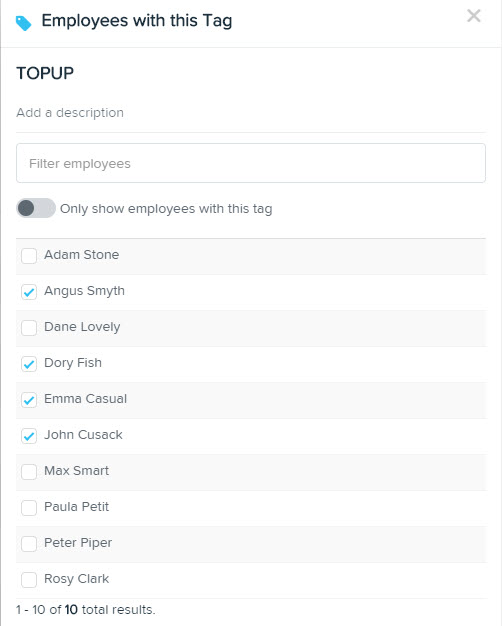
More information about tags can be found here
Configuring the rule sets
If your employees are already attached to a rule set, you will need to add the rules in addition to the existing rule set so that they are still linked to the other existing rules. To do this, go to the 'Payroll settings' > 'Rule sets' page and click on the existing rule set. If they are attached to an award, you'll need to select the award first from the drop down box.
If your employee is not already attached to a rule set, and you don't want these rules to be part of any existing rule set, you can create a new one for this purpose. To do that, go to the 'Payroll settings' > 'Rule sets' page, and click the 'Add' button to the right of the page.
One thing to note about rule sets before going further is that rule sets work in order of evaluation from top to bottom, meaning the processing of the rules at the bottom happens last. In most cases, you want something that pays the employees more to happen at the bottom.
Top up of Standard hours where the employee works less than normal hours
Once you have your rule set in order, you'll need to create the following rule (called 'Top up of standard hours' or similar) using the below instructions:
- WHEN time worked in a week (you can change this to shift period, day etc to suit your needs)
- WHERE (you'll need to click the cog icon on the right to see this option) TAGS - employee has the following tags 'TOPUP' (remembering this is optional)
- IS greater than employee standard hours (be aware with this rule, the employee standard hours are those hours on the Employee file > Pay run defaults page).
- THEN add remaining time
- Click Save
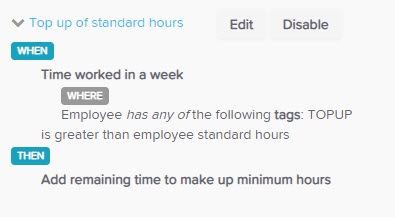
Restrict employee to standard hours where the employee works more than usual
In this scenario, even if the employee submits timesheets for hours greater than their standard hours, you can automate the system to ignore any hours above their standard.
Create a rule called 'Above standard hours' (or similar). This will be very similar to the first scenario rule....
- WHEN time worked in a week (you can change this to shift period, day etc to suit your needs)
- WHERE (you'll need to click the cog icon on the right to see this option) TAGS - employee has the following tags 'above standard hours' (remembering this is optional)
- IS greater than employee standard hours (be aware with this rule, the employee standard hours are those hours on the Employee file > Pay run defaults page.
- THEN apply pay category NONE
- Click Save
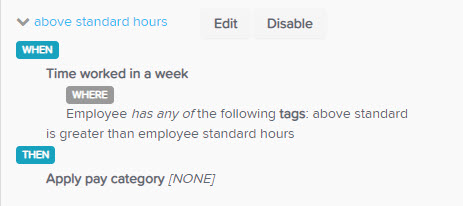
Including TIL....
The above rules do not make use of TIL in regards to the employee working under or over their standard hours, however, if you want the employee to accrue TIL when they work over their standard hours, you just need to tweak the rule a little to add an extra condition to the end:
- Select 'multiple actions'
- Add leave accrual of 1 unit per hour worked
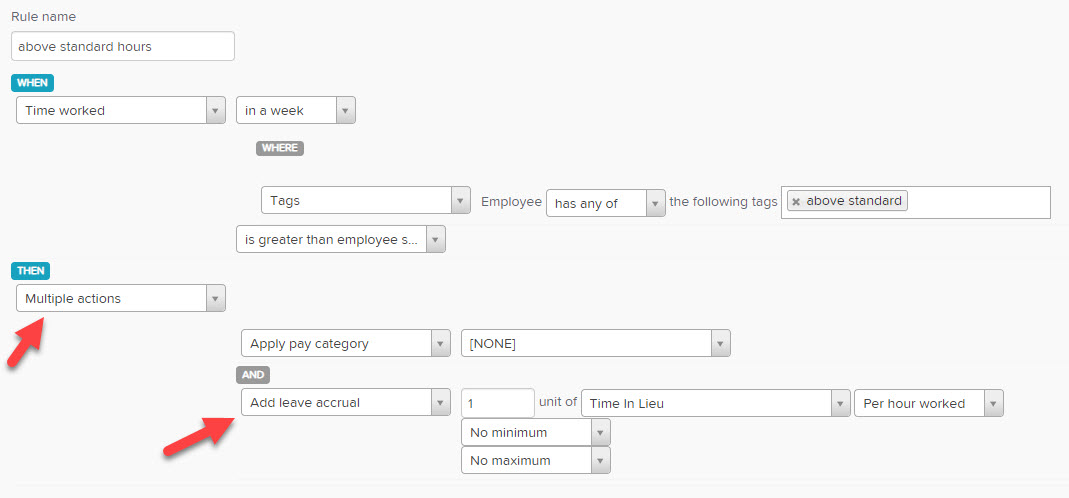
Likewise, if you want the employee's TIL balance to reduce when topping up hours if they work less than their standard, you'll need to add the below two extra conditions:
- Add leave accrual of -1 unit per hour worked
- Apply pay category NONE (because the TIL will pay the remaining time)
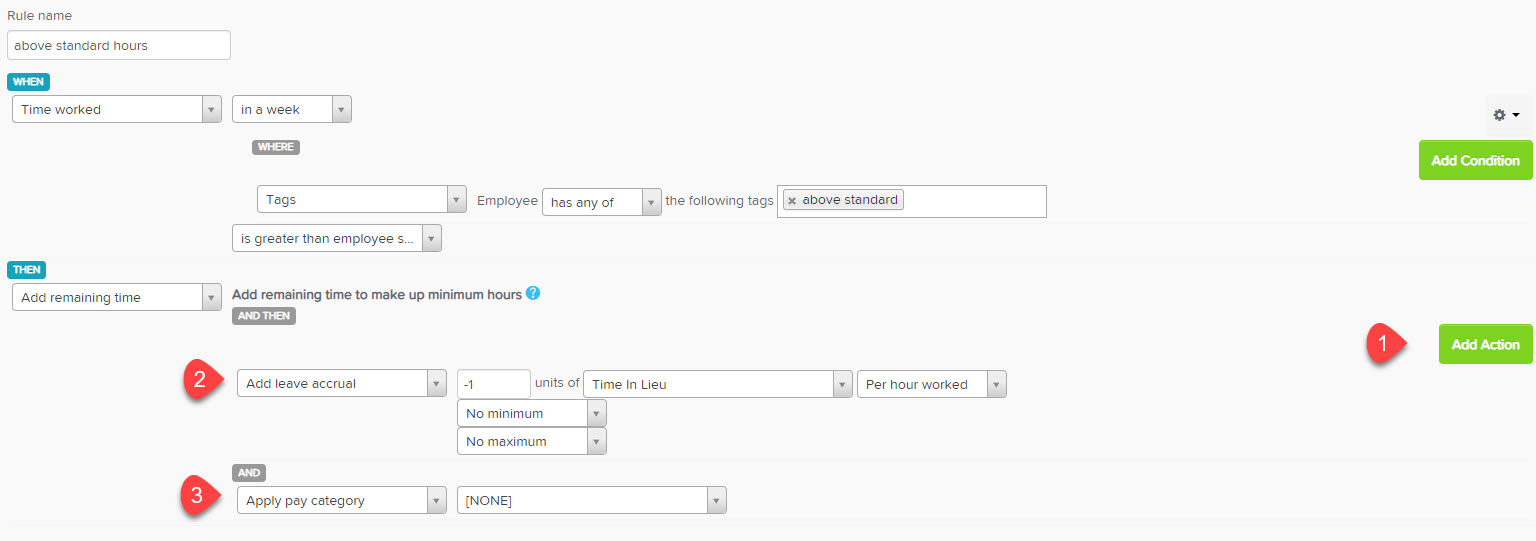
Testing the rules
You can check what's happening for each shift by using the rules tester...
- go to the Rule Sets page (under the pay conditions heading on the payroll settings tab)
- select the Award from the drop down menu at the top of the page (if nec)
- select the rule set you want to check
- hit the Test Rules button
- check the current period dates (the pay run period dates should match exactly to the current period or a previous period)
- click on the Import button
- select the employee whose shifts you want to test
- scroll down and hit Run Test
Once each day's earnings are displayed you can expand the day you want to check and click on the question mark to show you the list of rules that have been triggered by that shift, eg...
Then you can go check each rule that was triggered and see how/why it has been applied to that shift - keep in mind that rules are applied in order from top to bottom so a rule that's triggered may be overridden by another rule further down the list.
If you have any questions or feedback please let us know via support@yourpayroll.com.au
